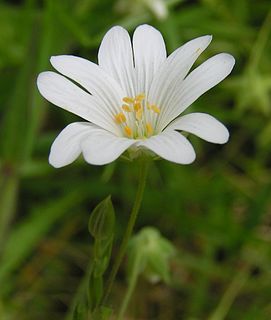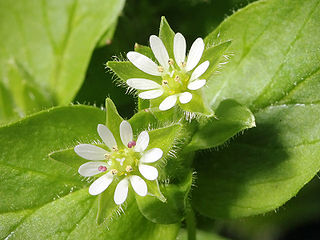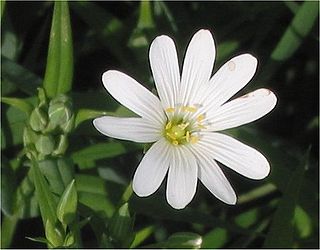
Stellaria is a genus of about 90 to 120 species of flowering plants in the family Caryophyllaceae, with a cosmopolitan distribution. Common names include starwort, stitchwort and chickweed.

Beaucarnea recurvata, the elephant's foot or ponytail palm, is a species of plant in the family Asparagaceae. The species was native to numerous states of eastern Mexico but is now confined to the state of Veracruz. Despite its common name, it is not closely related to the true palms (Arecaceae). It has become popular in Europe and worldwide as an ornamental plant. There are 350-year-old Beaucarneas registered in Mexico.

Stellaria media, chickweed, is an annual and perennial flowering plant in the family Caryophyllaceae. It is native to Eurasia and naturalized throughout the world. This species is used as a cooling herbal remedy, and grown as a vegetable crop and ground cover for both human and poultry consumption. It is sometimes called common chickweed to distinguish it from other plants called chickweed. Other common names include chickenwort, craches, maruns, and winterweed. The plant germinates in autumn or late winter, then forms large mats of foliage.

Rabelera holostea, known as greater stitchwort, greater starwort, and addersmeat, is a perennial herbaceous flowering plant in the family Caryophyllaceae. It was formerly placed in the genus Stellaria, as Stellaria holostea, but was transferred to the genus Rabelera in 2019 based on phylogenetic analyses. It is the only species in the genus Rabelera. Greater stitchwort is native to Western and Central Europe, including the British Isles.

Tillandsia recurvata, commonly known as small ballmoss or ball moss, is a flowering plant in the family Bromeliaceae that grows upon larger host plants. It grows well in areas with low light, little airflow, and high humidity, which is commonly provided by southern shade trees, often the southern live oak. It is not a parasite like mistletoe, but an epiphyte like its relative Spanish moss.

Stellaria graminea is a species of flowering plant in the family Caryophyllaceae known by the common names common starwort, grass-leaved stitchwort, lesser stitchwort and grass-like starwort.

Abies recurvata is a species of conifer in the family Pinaceae. It is found only in China. Abies recurvata is a distinct fir species usually recognized by the needles on its leaders mostly recurved or reflexed. It occurs in the drier, colder northern regions of central China in Sichuan and Gansu provinces at elevations between 2300 and 3600 m, usually on windy cliffs or in deep river valleys. Sometimes, however, also appears in dry low scrub on exposed mountain slopes. The most typical associated conifer species include Juniperus convallium, Juniperus formosana var. mairei, Juniperus squamata var. fargesii, Juniperus tibetica, Picea asperata, and Picea wilsonii. Abies recurvata is a small to medium-sized tree mostly with conical crown, occasionally reaching a height of 40 m, and a trunk diameter of 0.8 metres. It has rather smooth gray or rusty brown bark, at first shedding in thin plates, becoming grayish-brown and detaching in thick plates. The branchlets are grayish-white or light yellow with 1.2–2.5 centimetres (0.47–0.98 in) long needles horizontally outspreading on shade branches, radially outspreading on fertile branches; often thick and recurved, green to gray above and densely set with stoma-lines, with 2 light grayish-green stomatal bands below. Abies recurvata has 4–8 centimetres (1.6–3.1 in) long ovoid or cylindrical-ovoid, gray- or purplish blue cones; the bracts are somewhat shorter than the cone-scales, included or with slightly exposed tips.

Xenophora, commonly called carrier shells, is a genus of medium-sized to large sea snails, marine gastropod mollusks in the family Xenophoridae, the carrier snails or carrier shells. The genus Xenophora is the type genus of the family Xenophoridae.

The Circumboreal Region in phytogeography is a floristic region within the Holarctic Kingdom in Eurasia and North America, as delineated by such geobotanists as Josias Braun-Blanquet and Armen Takhtajan.
Torodora is a genus of moths in the family Lecithoceridae. The genus was erected by Edward Meyrick in 1894.

Aechmea recurvata is a plant species in the genus Aechmea. This species is native to southern Brazil, Paraguay, Uruguay and northern Argentina.

Stellaria chinensis is a species of large sea snail, a marine gastropod mollusk in the family Xenophoridae, the carrier shells.

Stellaria testigera, common name finger carrier shell, is a species of large sea snail, a marine gastropod mollusk in the family Xenophoridae, the carrier shells.

Stellaria is a genus of large sea snails, marine gastropod mollusks in the family Xenophoridae, the carrier shells.

Stellaria longipes is a species of flowering plant in the family Caryophyllaceae known by the common names longstalk starwort and Goldie's starwort. It has a circumpolar distribution, occurring throughout the northernmost latitudes of the Northern Hemisphere. It is a perennial herb that grows in a wide variety of habitat types, including tundra and taiga and many areas farther south with subalpine and alpine climates. It is extremely variable in morphology, its form depending on both genetic makeup and environmental conditions. It has a widely varying number of chromosomes. In general, it is a rhizomatous perennial herb forming mats or clumps, or growing erect. The stems may be short and simple or with sprawling and highly branched. The linear to lance-shaped leaves are usually 1 to 4 centimeters long and are oppositely arranged in pairs. The inflorescence bears one or more flowers, each on a short pedicel. The flower has five pointed green sepals each a few millimeters long. There are five white petals each divided into two lobes, sometimes shallowly, but often so deeply there appear to be two petals. The plant is gynodioecious, with some flowers having functional male and female reproductive parts and others being only female.

Coincya monensis is a plant species in the family Brassicaceae. Coincya monensis is native to western Europe and Morocco, but has been introduced in North America.

Stellaria alsine, the bog stitchwort, is a species of herbaceous perennial flowering plant in the carnation family Caryophyllaceae. It grows in bogs and marshes in Europe and parts of North America.
















